|
| Links | Andrena crataegi – Noted for coarse propodeum and curved and thickened inner hind tibial spur. Quite similar to A. forbesii.
- Hosts
|
80x5 -
240x3 -
240x4 -
320x1 -
320x2 -
320x3 -
640x1 -
640x2
Set display option above.
Click on
images to enlarge. |
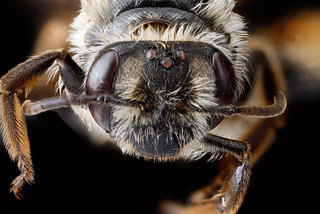
© Copyright source/photographer
· 9
Andrena crataegi, -female, -face 2012-08-07-18.55.32 |
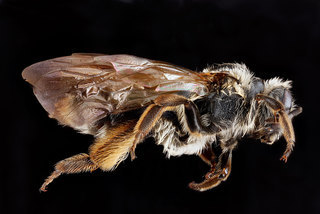
© Copyright source/photographer
· 9
Andrena crataegi, -female, -side 2012-08-07-19.11.46 |
|
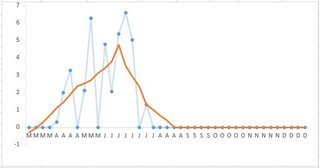
© Copyright source/photographer
· 9
Andrena crataegi, Mid-Atlantic Phenology |
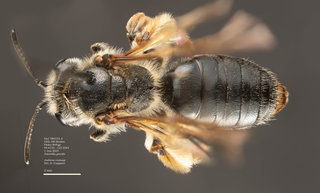
© Copyright source/photographer
· 9
Andrena crataegi, female, dorsal, DLC |
|
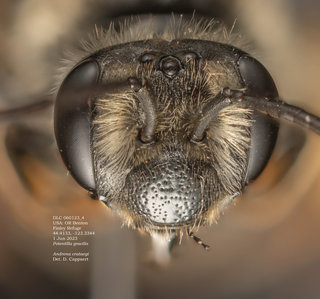
© Copyright source/photographer
· 9
Andrena crataegi, female, head, DLC |
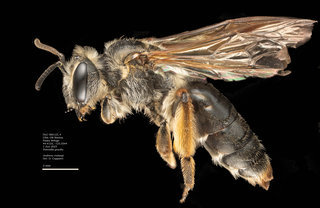
© Copyright source/photographer
· 9
Andrena crataegi, female, lateral, DLC |
|
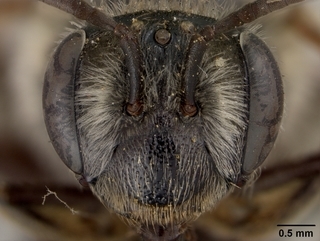
Smithsonian Institution, Entomology Department · 9
Andrena crataegi, female, face |
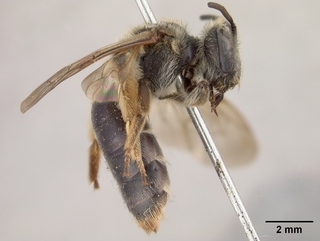
Smithsonian Institution, Entomology Department · 9
Andrena crataegi, female, side |
|
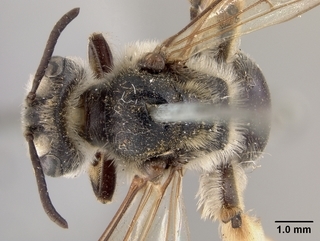
Smithsonian Institution, Entomology Department · 9
Andrena crataegi, female, top |
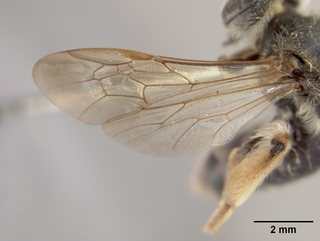
Smithsonian Institution, Entomology Department · 9
Andrena crataegi, female, wing |
|
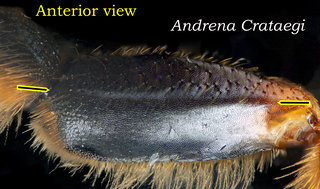
David Cappaert · 7
Andrena crataegi, legs, hind femur ridge, crataegi |
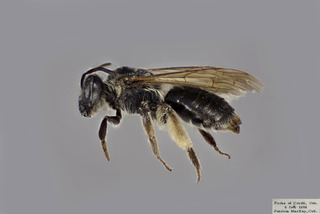
© Copyright Laurence Packer 2014
· 7
Andrena crataegi FEM CFP comp |
|
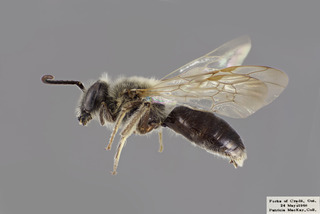
© Copyright Laurence Packer 2014
· 7
Andrena crataegi MALE CFP comp |
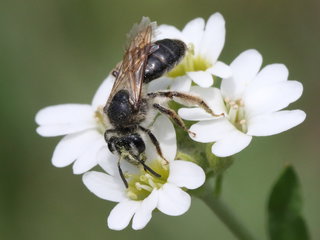
Michael Veit · 6
Andrena crataegi, f on Berteroa -- |
|
Overview |
Reprinted with permission of the American Entomological Society from:
LaBerge, W. E. 1969. A revision of the bees of the genus Andrena of the Western Hemisphere. Part II. Plastandrena, Aporandrena, Charitandrena. Transactions of the American Entomological Society 95: 1-47.
Please report text errors to: leah at discoverlife dot org.
This bee is not closely related to any of the other Plastandrena of North America. The male of crataegi resembles that of argemonis in having a black clypeus, but can be separated from the latter by the sixth sternum being strongly reflexed apically with the apicolateral corners produced into teeth. The female of crataegi is unlike the other species of Plastandrena in having the integument entirely black and by the hind femur having a complete carinate ridge along the lower-posterior surface.
FEMALE. MEASUREMENTS AND RATIOS. N = 20; length, 10-13 mm; width, 2.5-3.5 mm; wing length, M = 4.41 0.081 mm; FL/FW, M = 1.00 0.027; FOVL/FOVW, M = 3.11 0.052.
INTEGUMENTAL COLOR. Black except as follows: flagellar segments 3-10 below dark reddish-black to black; tegulae slightly translucent; wing veins dark reddish-brown to black, membranes lightly to moderately infumate, yellow to brown; distitarsi rufescent, tibial spurs testaceous; terga often slightly reddened especially apically.
STRUCTURE. Antennal scape length equal to flagellar segments 1-4; flagellar segment 1 equals segments 2 plus 3, 2 usually slightly shorter an 3. Eye about four times as long as broad, inner margins subparallel. malar space short, minimum length equals about one-sixth width. Mandible short, in repose extending only slightly beyond middle of labrum. Galea dulled by fine tessellation, short, broad; lateral portion broader than dorsal. Maxillary palpus considerably longer than galea, segmental ratio about 1.4: 2.0: 1.4: 1.2: 1.0: 1.2. Labial palpus with segment 1 slightly curved long inner margin, broader apically than basally; segmental ratio about 2.0: 1.6: 1.0: 1.0. Labral process about three times as broad as long, entire or slightly emarginate, moderately thickened apically; apical portion of labrum divided into three sections by crista extending from lateral parts of process to apical margin, median portion concave with one to three weak crista medially. Clypeus rounded, with coarse, relatively irregular, round punctures separated mostly by one-half to one puncture width, narrow mid-longitudinal line usually impunctate; surface shiny, reticular shagreening peripheral and coarse. Supraclypeal area with small round punctures and coarse reticular shagreening moderately dulling surface. Genal area slightly broader than eye in profile, with small round deep punctures separated mostly by one-half to one puncture width, surface shiny to moderately so. Vertex short, above lateral ocellus equal to slightly less than one ocellar diameter, surface moderately dulled by small round punctures and coarse tessellation. Face above antennal fossae coarsely rugulose, interrugal space punctate, moderately shiny. Facial fovea extends down to about posterior clypeal margin, separated from lateral ocellus by half an ocellar diameter or slightly more.
Pronotum normal, with scattered punctures laterally, dulled, shagreened. Mesoscutum with deep round punctures, peripherally separated mostly by half a puncture width or a little more, posteromedially irregularly separated by half to three or four puncture widths, surface shiny at least posteromedially, reticularly shagreened. Scutellum similar but punctures also crowded in median area. Metanotum with crowded round punctures and coarse tessellation dulling surface. Propodeum with enclosure irregularly rugose, surface dull, tessellate, dorsal area separated from posterior by a transverse ruga; dorsolateral and posterior areas finely and irregularly rugulose or punctatorugose, surface dull, tessellate; corbicular surface with small scattered punctures, short rugulae between some punctures especially posteriorly, surface moderately shiny, tessellate. Mesepisternum with coarse punctures with shiny bottoms so crowded as to leave only sharp ridges between punctures (punctatorugose). Hind femur with posteroventral surface with a complete carinate ridge from posterior tibiofemoral articulation to trochanter; hind tibia moderately cuneate. Pterostigma about as broad as from inner margin prestigma to wing margin; vein 1st m-cu usually meets second submarginal cell near middle of cell.
Metasomal tergum 1 with narrow impunctate apical margin, dorsally with deep, round punctures mostly separated by half a puncture width or slightly more, apical area punctures slightly smaller and more crowded, immediately basad of apical area and laterally a small area of sparser punctures; surface shiny. Terga 2-4 similar to 1 but surface at least slightly dulled on terga 3 and 4 by fine reticular shagreening and apicolateral, sparsely punctate areas of basal area of each tergum more distinct. Pygidial plate V-shaped with rounded apex and distinct raised internal triangle. Sterna 2-6 with narrow impunctate apical areas, basally with small round punctures separated mostly by half to one puncture width, surface moderately dulled by fine reticular shagreening.
VESTITURE. Cinereous or white to pale ochraceous (on dorsum of thorax and vertex slightly darker) except as follows: terga 5 and 6 medially with hairs golden to light brown; tarsi with inner surfaces red to reddish-brown; hind femur with apex, middle and fore tibiae with outer surfaces and middle and fore basitarsi brown to brownish-red. Metascutal and scutellar hairs erect, sparse medially. Terga 1-4 without apical pale fasciae, basal area hairs short, erect. Corbicula incomplete anteriorly with abundant internal hairs; trochanteral flocculus complete; tibial scopal hairs long, simple.
MALE. MEASUREMENTS AND RATIOS. N = 20; length. 9-12 mm; width, 2.3 mm; wing length, M = 3.90 0.051 mm; FL/FW, M = 1.10 0.007; FS1/FS2, M = 0.85 0.017.
INTEGUMENTAL COLOR. Black with same exceptions as female but wing membranes less deeply infumate and lower flagellar surface usually black.
STRUCTURE. Antennae long, in repose reaching propodeum; scape length slightly greater than flagellar segments 2 plus 3; flagellar segment 2 slightly shorter than segment 3, segments 3-11 one and one-half times as long as broad or longer. Eye about three and one-half times as long as broad, inner margins parallel or almost so. Malar space, mandible and galea as in female. Maxillary palpus as in female but segmental ratio about 1.2: 1.5: 1.0: 1.0: 1.0: 1.0. Labial palpus as in female but ratio about 1.8: 1.2: 1.0: 0.7. Labral process as in female but usually moderately emarginate; apical part of labrum without crista, convex, punctate. Clypeus as in female but punctures more crowded, regularly spaced and usually without impunctate median line. Supraclypeal area, genal area, vertex and ace as in female.
Thoracic sculpturing as in female but often less shagreened, shinier and lateral surface propodeum more completely rugulose and duller. Wing venation as in female. Hind tibial spur only slightly expanded near base, n some specimens normal.
Metasomal terga 1-5 sculptured as in female terga 1-4 but narrow apical impunctate margins narrower. Sterna 2-5 with basal punctures separated mostly by two to three puncture widths, surfaces moderately dulled by coarse reticular shagreening. Sternum 6 with apical margin strongly re-flexed with apicolateral corners produced, tooth-like.
Terminalia as in figures 4-28. Note the following: penis valves greatly swollen near base (basad of aedeagal opening); transverse sternum 7 with extremely shallow apical emargination and sharp basal apodemes; sternum 8 with long narrow neck and short, transverse apex.
VESTITURE. Much as in female except lacking pollen collecting hairs but last two terga with hairs cinereous to white and legs without brown or red hairs; inner surfaces tarsi pale golden-yellow.
REMARKS. The distribution (Fig. 1) of A. crataegi is remarkable enough to deserve comment. It appears that this species is distributed in two large areas, western and eastern, separated by a hiatus in the Great Plains States from North Dakota to Texas. That this hiatus is real and not a collecting artifact can be attested to by the author who has collected many times across the states of Nebraska and Kansas at the right time of the year without having found crataegi. The author has also been in the appropriate areas of Texas, Oklahoma, and South Dakota on at least a few occasions at the right time of the year without finding this bee. It is presumed that crataegi does occur in southern Manitoba, Alberta and, perhaps, Saskatchewan and parts of northern North Dakota. The two ranges would thus be connected, but evidence for such a connection is yet lacking.
In spite of this gap in distribution and the presumed narrow connection between two large populations with the attendant restriction of gene flow, A. crataegi is remarkably uniform in appearance. One cannot distinguish western from eastern specimens either externally or in the male terminalia. One must conclude that either this disjunct distribution is of relatively recent origin or that the rate of evolution in this species is extremely slow or both.
Reprinted with permission from: Mitchell, T.B. 1960. Bees of the Eastern United States. North Carolina Agricultural Experiment Station Technical Bulletin No. 141.
FEMALE. Length 11 mm.; clypeus evenly convex, projecting somewhat more than one-third below suborbital line, smooth and shining, deeply and rather coarsely punctate, the punctures well separated but hardly sparse, without a distinct, median, impunctate line; facial foveae rather broad, occupying above about three-fourths of space between eyes and ocelli, covered with whitish tomentum; space between margin of vertex and lateral ocelli subequal to their diameter; cheeks broader than eyes, rounded posteriorly, somewhat shining, very finely and rather closely punctate; malar space distinct, but short; basal segment of flagellum subequal to 2nd and 3rd combined; process of labrum broadly subtriangular, the apex rather narrowly truncate; pubescence of head and thorax short and sparse, especially on dorsum of thorax, entirely whitish-ochraceous, whitish on the more basal leg segments, becoming brownish apically on front and mid tibiae and on tarsi beneath; scutum and scutellum shining, finely and irregularly punctate, the punctures rather close anteriorly, becoming quite sparse and finer near middle of scutum posteriorly, very fine along anterior margin of scutellum, somewhat coarser and more sparse on its disc; pleura rather coarsely but shallowly rugose, without distinctly separated punctures; dorsal area of propodeum oblique, triangle coarsely reticulate, propodeal corbicula very short and poorly developed, without an anterior fringe, pale ochraceous; trochanteral floccus long and dense, whitish; hind tibiae rather slender, apex only slightly broader than basitarsi, scopa quite dense, hairs simple and moderately elongate, entirely whitish-ochraceous; front and mid basitarsi slightly narrower than their respective tibiae; posterior spur of hind tibiae long and quite strongly curved; wings rather strongly infuscated, 2nd submarginal cell considerably shorter than 3rd, receiving 1st recurrent slightly beyond middle; abdominal terga shining between the close and rather fine punctures, those on terga 2-4 becoming somewhat more sparse at margin of apical impressed area, these areas shallow, more finely and closely punctate, occupying medially about one-third length of disc and only very narrowly and obscurely hyaline along rims, discal pubescence hardly evident, extremely sparse, short and thin, suberect, apparently entirely pale, apical fasciae not developed, tergum 5 with a brownish, apical fimbria.
MALE. Length 10 mm.; face slightly longer than broad; clypeus evenly convex, projecting somewhat more than one-third below suborbital line, closely and deeply punctate, punctures rather fine, evenly distributed, without a median, impunctate line; space between margin of vertex and lateral ocelli subequal to their diameter; cheeks subequal to eyes in width, rounded posteriorly, somewhat shining, punctures very fine and quite close; malar space distinct but very short; basal segment of flagellum short, not much longer than apical width and shorter than 2nd segment; process of labrum short and quite broad, narrowed apically to the quite broadly truncate apex; mandibles rather short, with a distinct, inner, subapical tooth, overlapping very slightly; pubescence of head, thorax and legs rather short, somewhat dense, entirely pale ochraceous; scutum and scutellum deeply and quite coarsely punctate, intervening spaces shining, punctures very close anteriorly, becoming more definitely separated posteriorly in center of scutum and on scutellum; pleura rather coarsely rugose; dorsal area of propodeum coarsely reticulate, posterior face less coarsely so, lateral faces becoming more rugose, triangle poorly defined; legs piceous, apical tarsal segments becoming more testaceous, all basitarsi slender and elongate; inner hind tibial spur rather strongly curved; tegulae piceous; wings rather strongly infuscated, 2nd submarginal cell considerably shorter than 3rd, receiving 1st recurrent very slightly beyond middle; abdominal terga smooth and shining, deeply and rather closely and finely punctate, punctures slightly more widely separated toward margin of impressed areas, these quite distinct, but rather narrow, with much finer punctures, discal pubescence very short, suberect, entirely pale, fasciae not developed; apical margin of sternum 6 quite strongly reflexed especially at lateral angles; apical portion of sternum 8 rather gradually narrowed form base to the narrowly rounded, subtruncate apex, slightly protuberant medially beneath, clothed with rather long and dense pubescence; penis valves slender apically, very strongly dilated basally, not excavated laterally; gonocoxites quite robust, abruptly dilated medially to form two elongate, apically rounded lobes, which are somewhat excavated on upper surface, gonocoxal lobes not developed.
DISTRIBUTION. Southern Canada and the Northern United States from British Columbia and Oregon to Nova Scotia and the New England states, south to North Carolina and Georgia; March to August.
FLOWER RECORDS. Amelanchier, Aruncus, Brassica, Castanea, Ceanothus, Chrysanthemum, Cornus, Crataegus, Hydrangea, Malus, Potentilla, Prunus, Rhus, Rubus and Viburnum. Recorded by Robertson (1929) on Aruncus, Blephilia, Eulophus, Heracleum, Pastinaca, Philadelphus, Polytaenia, Prunus, Ptelea, Rhamnus, Salix, Taenidia and Zizia. Recorded also by Brittain and Newton (1933 & 1934) on the following additional genera: Caragana, Diervilla, Narcissus, Pyrus, Rosa, Spiraea, Taraxacum, Trifolium, Tulipa and Vaccinium.
Described using the synonymous name: Andrena angusi Viereck
FEMALE. Length 13 mm.; eyes about parallel; foveae narrow, occupying about half of space between eyes and ocelli, reaching level of upper margin of clypeus; vertex broad, ocelli separated from its margin by fully twice their diameter; cheeks broader than eyes (about 3:2); clypeus strongly protuberant, shining, closely and deeply punctate, with interspaces no more than diameter of punctures, with a narrow but distinct median impunctate line; malar space evident but very short; process of labrum large, triangular, apex very deeply emarginate; basal segment of flagellum equal to segments 2 and 3 combined; pubescence of head and thorax entirely pale ochraceous to whitish; scutum and scutellum finely and evenly punctate, punctures close except near center; pleura somewhat shining, punctures fine, close and rather indefinite; propodeal triangle finely rugose, lateral faces subrugose, propodeal corbicula short and poorly developed; trochanteral floccus well developed, long, curved and distinctly plumose; tibial scope pale ochraceous, rather thin, plumosities short and at right angles to shaft of hair (as in Ptilandrena), legs otherwise entirely pale pubescent, hind tibiae and mid and hind basitarsi quite narrow and elongate; wings lightly infuscated, veins and stigma ferruginous; 2nd submarginal nearly as long as 3rd, receiving 1st recurrent vein at middle; tegulae testaceous-hyaline; abdominal terga smooth, punctures very fine and well separated, apical impressed areas about one-third median length of discs, testaceous-hyaline and nearly impunctate, discal pubescence very short, entirely pale, apical fasciae poorly developed, evident only laterally on segments 2-4, tergum 5 with a fulvous apical fimbria.
DISTRIBUTION. This was described in a key to species occurring or likely to occur in Connecticut. No other reference to the collection data is given, and the type specimen, which is unique, bears no collection information. The description above was made from this type specimen in the Philadelphia Academy of Science.
|
|
|
Kinds | |
Extracted from Joel Gardner. "The mining bees of Minnesota (unpublished manuscript)" Andrena crataegi is the only Plastandrena species in Minnesota. It is easily recognized by the strong punctures and rough sculpture of the mesopleura and propodeum, the strongly
curved posterior hind tibial spur (less strongly curved in the male), and the strongly reflexed apicolateral corners of S6 in the male. It resembles and is commonly confused with the other
strongly sculptured subgenera Scrapteropsis and Trachandrena, but the female hind tibial spur and the male S6 will readily separate it. This is a common, widespread species often collected in large numbers.
|
|
|
Identification | |
This species is sometimes confused with species in Trachandrena as it sometimes has a rim on the propodeal triangle where the tip transitions from the dorsal to the rear face. However, in the male, if you look at the apical rim of S6 you will find that two corners are clearly folded back on themselves, giving it a dog-eared look.
|
|
|
Names | |
|
|
| Supported by | |
Updated: 2024-07-27 01:47:35 gmt
|